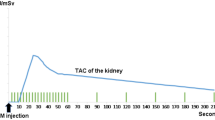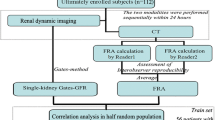Abstract
Purpose
This study aims to determine whether contrast-enhanced (CE)-magnetic resonance imaging (MRI) is comparable to CE-computed tomography (CT) for estimation of split renal function (SRF). For this purpose, two different kidney volumetry methods, the renal cortex volumetry (RCV) and modified ellipsoid volume (MELV), are compared for both acquisition types (CT vs. MRI) with regard to accuracy and reliability, subsequently referred to as RCVCT/RCVMRI and MELVCT/MELVMRI.
Methods
This retrospective study included 29 patients (18 men and 11 women; mean age 62.8 ± 12.4 years) who underwent CE-MRI and CE-CT of the abdomen within a period of 3 months. Two independent readers (R1/R2) performed RCV and MELV in all datasets with corresponding semiautomated software tools. RCV was performed with datasets in the arterial phase and MELV in the venous phase. Statistics were calculated using one-way ANOVA, two-tailed Student’s t test, Pearson´s correlation, and Bland–Altman plots with p ≤ 0.05 being considered statistically significant.
Results
In all datasets, SRF was almost identical for both volumetry methods with a mean difference of < 1%. Bland–Altman analysis comparing RCV in CT and MRI showed very good agreement for R1/R2. Interreader agreement was strong for RCVCT and good for RCVMRI (r = 0.89; r = 0.69). MELVCT/MRI interreader agreement was only moderate (r = 0.54; r = 0.50) with a high range of values. Intrareader agreement was excellent for all measurements, except MELVMRI which showed a high mean bias and range of values (RCVCT: r = 0.93, RCVMRI: r = 0.98, MELVCT: r = 0.89, MELVMRI: r = 0.54).
Conclusion
Renal volumetric estimates of SRF are almost as accurate and reliable with CE-MRI as with CE-CT using RCV method. In distinction, the calculation of SRF using MELV was inferior to RCV with respect to accuracy and reliability. Thus, RCV method is recommended to estimate SRF, primarily using CT datasets. However, RCV with MRI datasets for kidney volumetry allows for comparable accuracy and reliability while sparing patients and healthy donors of unnecessary radiation exposure.




Similar content being viewed by others
Abbreviations
- CE:
-
Contrast-enhanced
- CI:
-
Confidence interval
- eGFR:
-
Estimated glomerular filtration rate calculated with the “chronic kidney disease epidemiology collaboration” (CKD-EPI) formula
- LKD:
-
Living kidney donation
- LoA:
-
Limits of agreement
- MELV:
-
Modified ellipsoid volume
- MELVCT :
-
MELV measurements performed using venous-phase images acquired with CE-CT
- MELVMRI :
-
MELV measurements performed using venous-phase images acquired with CE-MRI
- MIP:
-
Maximum intensity projection
- NASCET:
-
The North American Symptomatic Carotid Endarterectomy Trial
- RCV:
-
Renal cortex volumetry
- RCVCT :
-
RCV measurements performed using arterial-phase images acquired with CE-CT
- RCVMRI :
-
RCV measurements performed using arterial-phase images acquired with CE-MRI
- ROI:
-
Region of interest
- SRF:
-
Split renal function
- TKV:
-
Total kidney volume
References
Ibrahim HN, Foley R, Tan L, et al. (2009) Long-term consequences of kidney donation. N Engl J Med 360:459–469. https://doi.org/10.1056/NEJMoa0804883
Terasaki PI, Cecka JM, Gjertson DW, Takemoto S (1995) High Survival Rates of Kidney Transplants from Spousal and Living Unrelated Donors. N Engl J Med 333:333–336. https://doi.org/10.1056/NEJM199508103330601
Wolfe RA, Ashby VB, Milford EL, et al. (1999) Comparison of mortality in all patients on dialysis, patients on dialysis awaiting transplantation, and recipients of a first cadaveric transplant. N Engl J Med 341:1725–1730. https://doi.org/10.1056/NEJM199912023412303
Halleck F, Diederichs G, Koehlitz T, et al. (2013) Volume matters: cT-based renal cortex volume measurement in the evaluation of living kidney donors. Transpl Int 26:1208–1216. https://doi.org/10.1111/tri.12195
Wahba R, Franke M, Hellmich M, et al. (2016) Computed Tomography Volumetry in Preoperative Living Kidney Donor Assessment for Prediction of Split Renal Function. Transplantation 100:1270–1277. https://doi.org/10.1097/TP.0000000000000889
Soga S, Britz-Cunningham S, Kumamaru KK, et al. (2012) Comprehensive comparative study of computed tomography-based estimates of split renal function for potential renal donors: modified ellipsoid method and other CT-based methods. J Comput Assist Tomogr 36:323–329. https://doi.org/10.1097/RCT.0b013e318251db15
Kato F, Kamishima T, Morita K, et al. (2011) Rapid estimation of split renal function in kidney donors using software developed for computed tomographic renal volumetry. Eur J Radiol 79:15–20. https://doi.org/10.1016/j.ejrad.2009.11.013
Seuss H, Janka R, Prümmer M, et al. (2017) Development and Evaluation of a Semi-automated Segmentation Tool and a Modified Ellipsoid Formula for Volumetric Analysis of the Kidney in Non-contrast T2-Weighted MR Images. J Digit Imaging 30:244–254. https://doi.org/10.1007/s10278-016-9936-3
Gardan E, Jacquemont L, Perret C, et al. (2018) Renal cortical volume: high correlation with pre- and post-operative renal function in living kidney donors. Eur J Radiol 99:118–123. https://doi.org/10.1016/j.ejrad.2017.12.013
Hyodoh H, Shirase R, Kawaharada N, et al. (2009) MR angiography for detecting the artery of Adamkiewicz and its branching level from the aorta. Magn Reson Med Sci 8:159–164. https://doi.org/10.2463/mrms.8.159
Schneider G, Massmann A, Altmeyer K, Katoh M, Bücker A (2007) MR imaging and MR angiography of the aorta. Radiologe 47:993–1002. https://doi.org/10.1007/s00117-007-1582-9
Karlo C, Reiner CS, Stolzmann P, et al. (2010) CT- and MRI-based volumetry of resected liver specimen: comparison to intraoperative volume and weight measurements and calculation of conversion factors. Eur J Radiol 75:e107–e111. https://doi.org/10.1016/j.ejrad.2009.09.005
Lee J, Kim KW, Kim SY, et al. (2014) Feasibility of semiautomated MR volumetry using gadoxetic acid-enhanced MRI at hepatobiliary phase for living liver donors. Magn Reson Med 72:640–645. https://doi.org/10.1002/mrm.24964
Huynh HT, Karademir I, Oto A, Suzuki K (2014) Computerized liver volumetry on MRI by using 3D geodesic active contour segmentation. Am J Roentgenol 202:152–159. https://doi.org/10.2214/AJR.13.10812
Shimoyama H, Isotani S, China T, et al. (2017) Automated renal cortical volume measurement for assessment of renal function in patients undergoing radical nephrectomy. Clin Exp Nephrol 21:1124–1130. https://doi.org/10.1007/s10157-017-1404-y
Will S, Martirosian P, Würslin C, Schick F (2014) Automated segmentation and volumetric analysis of renal cortex, medulla, and pelvis based on non-contrast-enhanced T1- and T2-weighted MR images. MAGMA 27:445–454. https://doi.org/10.1007/s10334-014-0429-4
Cheong B, Muthupillai R, Rubin MF, Flamm SD (2007) Normal values for renal length and volume as measured by magnetic resonance imaging. Clin J Am Soc Nephrol 2:38–45. https://doi.org/10.2215/CJN.00930306
Funding
This research did not receive any specific grant from funding agencies in the public, commercial, or not-for-profit sectors.
Author information
Authors and Affiliations
Corresponding author
Ethics declarations
Conflict of interest
All authors approve publication of our work and have no conflict of interest.
Ethical approval
All procedures performed in studies involving human participants were in accordance with the ethical standards of the institutional and/or national research committee and with the 1964 Helsinki declaration and its later amendments or comparable ethical standards. For this type of study formal consent is not required.
Rights and permissions
About this article
Cite this article
Siedek, F., Haneder, S., Dörner, J. et al. Estimation of split renal function using different volumetric methods: inter- and intraindividual comparison between MRI and CT. Abdom Radiol 44, 1481–1492 (2019). https://doi.org/10.1007/s00261-018-1857-9
Published:
Issue Date:
DOI: https://doi.org/10.1007/s00261-018-1857-9




